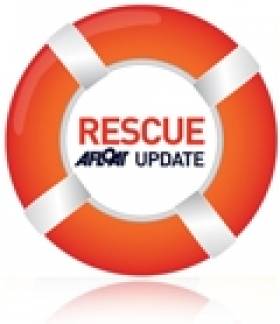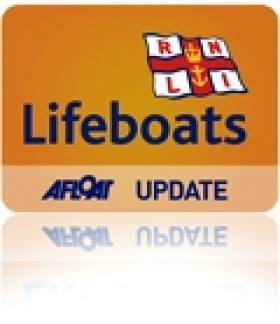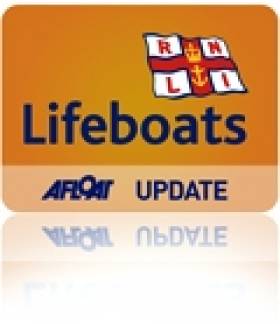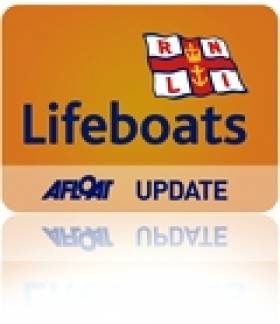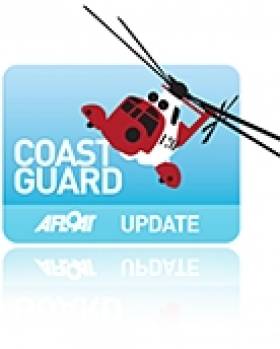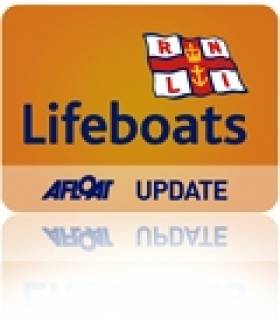Displaying items by tag: Rescue
New Rescue Boat Launched for Ballybunion Sea and Cliff Rescue Service
Ballybunion Sea & Cliff Rescue Service in North Kerry officially launched their new Atlantic 75 rescue boat yesterday.
After three years of negotiations and build time the 7.5 metre Rigid Inflatable Boat arrived earlier this year. After several months of sucessful sea trials the boat entered full active service at the weekend, althought its first call out in anger occured last week to tow a stricken vessel that had lost engine power.
The unit depends fully on public donations and a small government grant to run the unit each year at a cost of over €40,000.
The boat was officially named by Derek Nagle, a member of the Duggan family in Ballybunion who have long been assosiated with the unit as supporters. The vessel was named the "Tommy C" after Tommy Duggan and his Wife Clara. The previous boat, an Atlantic 21 was named the "Clara T".
Related Safety posts
RNLI Lifeboats in Ireland
Safety News
Rescue News from RNLI Lifeboats in Ireland
Coast Guard News from Ireland
Water Safety News from Ireland
Marine Casualty Investigation Board News
Marine Warnings
County Antrim's Red Bay Lifeboat crew launched this evening (Saturday 7 August 2010) to rescue a brother and sister who had got into difficulty in the Boulder Field on Fair Head rocks on the North Antrim Coast. This is the first callout for Red Bay's new Atlantic 85 lifeboat Geoffrey Charles.
The call for help was received at 18.25 this evening when the siblings went walking in the Boulder field and got into difficulty. The Red Bay lifeboat was launched and in a heavy swell manoeuvred close to the rocks. One of the volunteer lifeboat crew then swam from the lifeboat onto the rocks with another crewmember's drysuit and a lifejacket. He then assisted the casualties one at a time using a rope.
Under difficult conditions the two casualties were recovered onto the lifeboat and landed at Ballycastle. No further medical attention was needed. Commenting on the rescue Red Bay RNLI helm Paddy McLaughlin said, " Although people like to walk in this scenic area of North Antrim it can be a very dangerous spot. This was a successful first callout for our new lifeboat and the two people are recovering well from their ordeal."
The new lifeboat was only put on station less than a fortnight ago. It has a number of improvements on its predecessor including a faster top speed of 35 knots; radar; provision for a fourth crew member and more space for survivors. It can operate safely in daylight in up to force 7 conditions and at night in up to force 6, it is also capable of being beached in an emergency.
Related Safety posts
RNLI Lifeboats in Ireland
Safety News
Rescue News from RNLI Lifeboats in Ireland
Coast Guard News from Ireland
Water Safety News from Ireland
Marine Casualty Investigation Board News
Marine Warnings
Cork Week Sailors in Dramatic Rescue
A competitor returning to England from Cork Week was rescued after going overboard 50 miles off Land's End. Prue Nash, a yacht broker from Cowes, spent two hours in the water wihout a lifejacket and was lucky to survive the ordeal that took place in the early hours of Sunday morning.
Volunteer lifeboat crews from Sennen Cove and St Mary’s, Isles of Scilly, were launched in the early hours of Sunday morning following reports that the yachtswoman had fallen overboard 50 miles north west of Land’s End. Just before the lifeboats arrive on scene, the extremely fortunate sailor was found by another yacht and airlifted to hospital.
Nash was wearing a life jacket and harness when she went over the edge, but had to take them off after they became trapped and were pinning her underwater.
The racing yacht Buccaneer was returning from Cork Week Regatta in Ireland when the woman went overboard in fresh south westerly winds and a moderate sea. Another yacht, Jaguar Logic, relayed a message to Falmouth coastguards and the two lifeboats were launched, along with the rescue helicopter from RAF Chivenor.
The RNLI crews on Sennen Cove Tamar class all weather lifeboat and the St Mary’s Severn class all weather lifeboat headed for the scene at top speed. But just 12 or so miles from the scene, news came that the woman, who had been in the water for two hours, had been found alive and was being winched onboard the helicopter. She was then flown to the Royal Cornwall Hospital at Treliske in Truro, Cornwall.
The Sennen Cove lifeboat crew onboard City of London III, arrived home at 5am in the morning after an 80 mile round trip, while the crew onboard the St Mary’s relief lifeboat Beth Sells, were back in the islands at around the same time.
Terry George, RNLI Coxswain at Sennen Cove, says the woman was extremely fortunate:
‘The yachtswoman was very lucky to survive several hours in the water and in the pitch dark. Fortunately there were other yachts in the area that responded immediately and search and rescue assets were launched very quickly too. It happened a long way out but this is why the RNLI position fast response all weather lifeboats like our Tamar, at key places around the coast.’
Related Safety posts
RNLI Lifeboats in Ireland
Safety News
Rescue News from RNLI Lifeboats in Ireland
Coast Guard News from Ireland
Water Safety News from Ireland
Marine Casualty Investigation Board News
Marine Warnings
Trawler Fouls Prop, Calls Lifeboat for Tow
Ballycotton lifeboat was called on to lend assistance to a 23 metre fishing vessel in difficulties, 31 miles south of Ballycotton today. The Irish registered vessel, with five on board, contacted the emergency services when they fouled their propeller. The Ballycotton lifeboat, Austin Lidbury, arrived on scene at 12:00 and established a towline. The vessel was safely towed to Ballycotton harbour.
Related Safety posts
RNLI Lifeboats in Ireland
Safety News
Rescue News from RNLI Lifeboats in Ireland
Coast Guard News from Ireland
Water Safety News from Ireland
Marine Casualty Investigation Board News
Marine Warnings
Coastguard holds man against rock until help arrives
The first report was that the man had been fishing and was clinging on to the rocks in order to save himself. He was unable to be reached from the shoreline.
The Newcastle Coastguard Team, recently trained in swift water rescue, was quickly on scene and a team member, John Lowry, suitably equipped was assisted down to the man to help him stay close to the rocks whilst further assistance from the local inshore lifeboat was requested.
Once taken ashore he was delivered into the waiting arms of paramedics at the harbour and taken to hospital by ambulance.
Alan Pritchard, Duty Watch Manager at Belfast Coastguard said:
"Seemingly the man had been in water for quite some time. He had fallen in and was clinging to rocks. Our first informant was a passer by who just happened to hear his calls. The man in the water was very close to letting go of rock, so John, our Coastguard Team Station Officer with our new water rescue equipment went in to hold him, and the casualty was very hypothermic when he came out of the water. We'd like to congratulate John for his outstanding efforts in rescuing this fisherman in the finest Coastguard traditions."
Lifeboats Rescue Man Overboard off Antrim Coast
On a busy Sunday for RNLI lifeboat crews off the north Antrim Coast both Red Bay and Portrush RNLI lifeboat crews launched at 9.22am this morning to reports of a vessel in difficulty with two people onboard off Sheep Island at Ballintoy.
The 16 foot fishing boat got into difficulties when an anchor went down and a crewmember from the vessel bent over the bow of the boat in an attempt to retrieve it. He was caught by a wave and pulled into the freezing water.
When the lifeboats arrived on scene the man had been recovered onto the vessel by the other crewmember. Conditions were poor with a force five in evidence and a big swell. Both men were suffering from the cold and were in shock. The vessel was clearly in great difficulty and the two men were transferred onboard the Portrush all weather lifeboat while Red Bay RNLI towed the vessel back to land. A waiting ambulance met the casualties at Ballycastle.

Commenting on the rescue Red Bay RNLI helm Paddy McLaughlin said, “These two men were extremely lucky today. One man had already entered the freezing water before getting back on the boat and they were both in need of medical assistance by the time we had reached them.”
The rescue operation lasted for three hours and was the second major rescue for the RNLI in the area that morning. Portrush RNLI inshore lifeboat crew rescued two men from the sea while their all weather lifeboat assisted Red Bay with the Ballintoy callout.
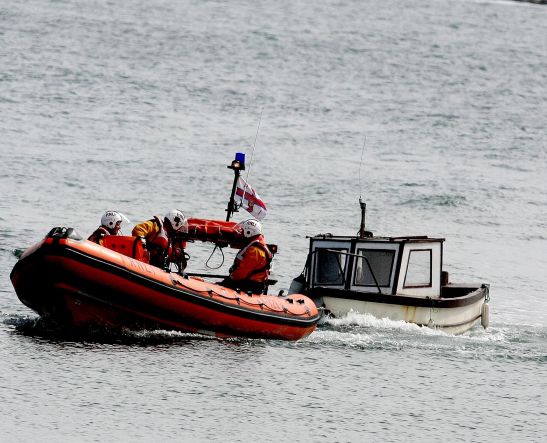
Additional report from MCA:
The emergency 999 call was made at 9.15 this morning alerting the marine emergency service and that the cruiser with two people on board was in extreme difficulty and without power.
The Coastguard immediately relayed a mayday signal into the area to alert other vessels to the on going emergency.
The Portrush and Redbay lifeboats were also asked to launch and a rescue helicopter was initially scrambled from the Royal Naval Air Station at Prestwick, however by this time the man had been recovered to the vessel and it was stood down. His colleagues on board the cabin cruiser indicated that he was very cold but there were no visible injuries and that he was slowly warming up, but they remained without power as a rope had been caught around its propeller and were experiencing very heavy weather. The Portrush all weather lifeboat picked up the man who gone into the water and a colleague and brought them will all speed back to Ballycastle. The Redbay lifeboat is now bringing the vessel under tow back to Ballycastle.
Meanwhile a further call was taken from Portrush promenade where a member of the public had spotted two people in the water shouting for help. Both were drunk and had been caught in the rip tide off West Strand. The Coastguard began broadcasting into the area immediately requesting vessels to go to his assistance and the Portrush inshore lifeboat was on scene very quickly and recovered both people to the lifeboat. An ambulance was requested and the lifeboat was met by the Coleraine Coastguard Rescue Team and paramedics.
Alan Pritchard, Duty Watch Manager at Belfast Coastguard said:
“It is clear that the weather is going to be somewhat rough today with rain forecast. We are asking the boating public and those who will be visiting the coastline to take that extra bit of care. Make sure you have some communication with you, and of course if you go afloat wear a lifejacket! The two men who went into the water whilst under the influence of drink are very poorly in hospital, and we cannot stress enough how dangerous it is going into the sea whilst drinking.”
Man wearing lifejacket is rescued from River Tweed
A man has been rescued from the River Tweed after falling from a ladder whilst boarding his angling boat. Lynda Bell, watch officer at Humber Coastguard says:
We received a 999 call at 11.40 this morning reporting that the man had fallen in the water and asking for assistance. The caller had heard the man shouting for help and we could still hear him shouting for help in the background as the 999 call was made.
“We requested the Berwick RNLI inshore lifeboat to launch and it was soon on scene picking the man up from the water.
"The 69 year old, who is from the Berwick area, was wearing a lifejacket so this meant that we were able to recover him from the water very quickly. He also did exactly the right thing by shouting for help as soon as he entered the water. After a quick check over by ambulance paramedics he was allowed home.
“This incident shows just how crucial a lifejacket can be. It can mean the difference between a swift and simple rescue or a protracted search with a possible fatal outcome. Please remember to wear your lifejacket. It’s useless unless worn.”
Boru Dive Unit

Boru Dive Unit
The principal activities of the club include diving, search and rescue and powerboating.
Boru Dive Unit, c/o Jason Kenny, Shanley, Inchdrinagh, Ballina/Killaloe. Email: [email protected]
Have we got your club details? Click here to get involved



























